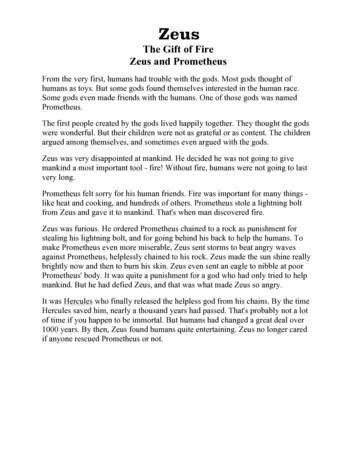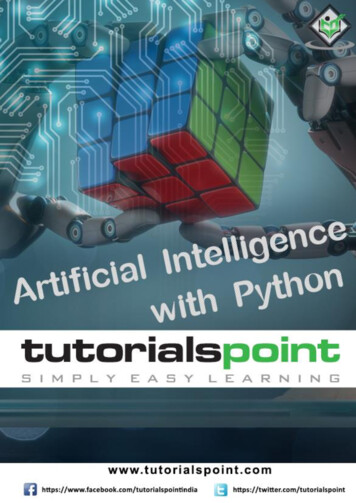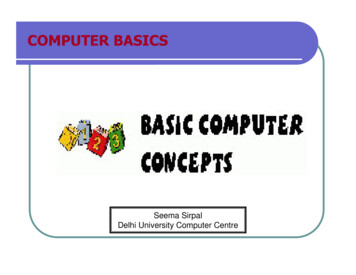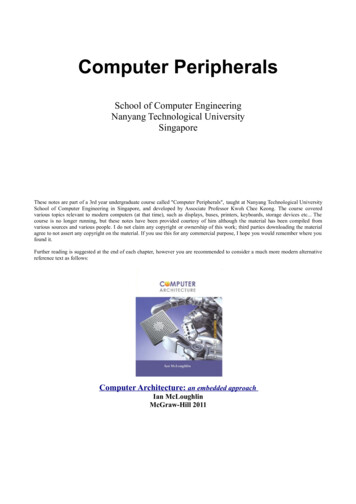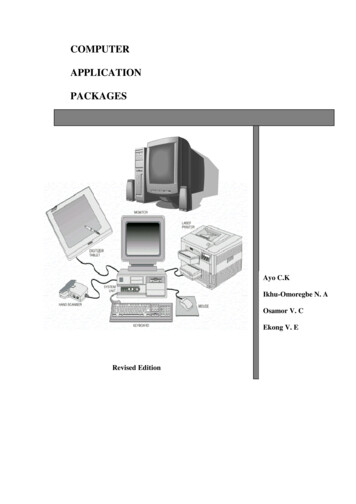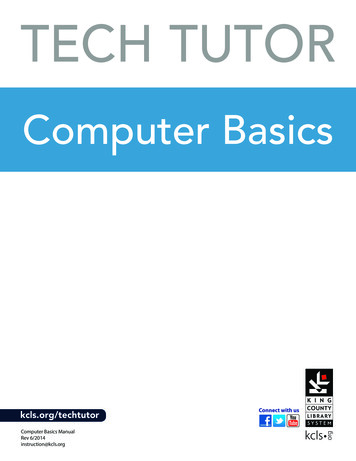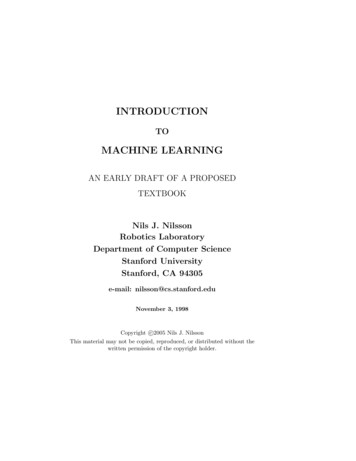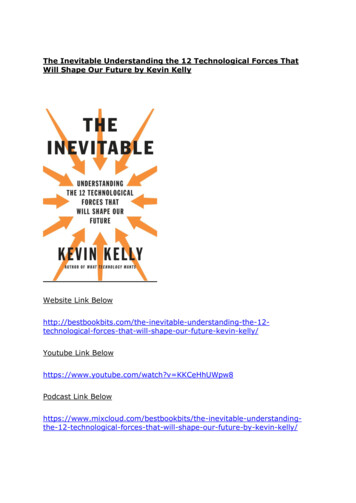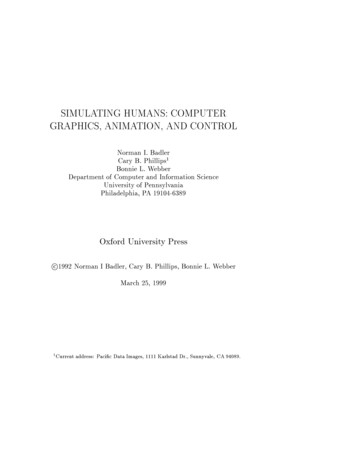
Transcription
SIMULATING HUMANS: COMPUTERGRAPHICS, ANIMATION, AND CONTROLNorman I. BadlerCary B. Phillips1Bonnie L. WebberDepartment of Computer and Information ScienceUniversity of PennsylvaniaPhiladelphia, PA 19104-6389Oxford University Pressc 1992 Norman I Badler, Cary B. Phillips, Bonnie L. WebberMarch 25, 19991Current address: Paci c Data Images, 1111 Karlstad Dr., Sunnyvale, CA 94089.
iTo Ginny, Denise, and Mark
ii
Contents1 Introduction and Historical Background1.1 Why Make Human Figure Models? : : : : : : : : : : : : : : : :1.2 Historical Roots : : : : : : : : : : : : : : : : : : : : : : : : : : :1.3 What is Currently Possible? : : : : : : : : : : : : : : : : : : : :1.3.1 A Human Model must be Structured Like the HumanSkeletal System : : : : : : : : : : : : : : : : : : : : : : :1.3.2 A Human Model should Move or Respond Like a Human1.3.3 A Human Model should be Sized According to Permissible Human Dimensions : : : : : : : : : : : : : : : : : :1.3.4 A Human Model should have a Human-Like Appearance1.3.5 A Human Model must Exist, Work, Act and ReactWithin a 3D Virtual Environment : : : : : : : : : : : :1.3.6 Use the Computer to Analyze Synthetic Behaviors : : :1.3.7 An Interactive Software Tool must be Designed for Usability : : : : : : : : : : : : : : : : : : : : : : : : : : : :1.4 Manipulation, Animation, and Simulation : : : : : : : : : : : :1.5 What Did We Leave Out? : : : : : : : : : : : : : : : : : : : : :2 Body Modeling2.1 Geometric Body Modeling : : : : : : : : : : : : : :2.1.1 Surface and Boundary Models : : : : : : : :2.1.2 Volume and CSG Models : : : : : : : : : :2.1.3 The Principal Body Models Used : : : : : :2.2 Representing Articulated Figures : : : : : : : : : :2.2.1 Background : : : : : : : : : : : : : : : : : :2.2.2 The Terminology of Peabody : : : : : : : :2.2.3 The Peabody Hierarchy : : : : : : : : : : :2.2.4 Computing Global Coordinate Transforms :2.2.5 Dependent Joints : : : : : : : : : : : : : : :2.3 A Flexible Torso Model : : : : : : : : : : : : : : :2.3.1 Motion of the Spine : : : : : : : : : : : : :2.3.2 Input Parameters : : : : : : : : : : : : : : :2.3.3 Spine Target Position : : : : : : : : : : : :2.3.4 Spine Database : : : : : : : : : : : : : : : 33333436373838
CONTENTSiv2.4 Shoulder Complex : : : : : : : : : : : : : : : : : : :2.4.1 Primitive Arm Motions : : : : : : : : : : : :2.4.2 Allocation of Elevation and Abduction : : : :2.4.3 Implementation of Shoulder Complex : : : :2.5 Clothing Models : : : : : : : : : : : : : : : : : : : :2.5.1 Geometric Modeling of Clothes : : : : : : : :2.5.2 Draping Model : : : : : : : : : : : : : : : : :2.6 The Anthropometry Database : : : : : : : : : : : : :2.6.1 Anthropometry Issues : : : : : : : : : : : : :2.6.2 Implementation of Anthropometric Scaling :2.6.3 Joints and Joint Limits : : : : : : : : : : : :2.6.4 Mass : : : : : : : : : : : : : : : : : : : : : : :2.6.5 Moment of Inertia : : : : : : : : : : : : : : :2.6.6 Strength : : : : : : : : : : : : : : : : : : : : :2.7 The Anthropometry Spreadsheet : : : : : : : : : : :2.7.1 Interactive Access Anthropometric Database2.7.2 SASS and the Body Hierarchy : : : : : : : :2.7.3 The Rule System for Segment Scaling : : : :2.7.4 Figure Creation : : : : : : : : : : : : : : : : :2.7.5 Figure Scaling : : : : : : : : : : : : : : : : :2.8 Strength and Torque Display : : : : : : : : : : : : :2.8.1 Goals of Strength Data Display : : : : : : : :2.8.2 Design of Strength Data Displays : : : : : : :::::::::::::::::::::::::::::::::::::::::::3.1 Direct Manipulation : : : : : : : : : : : : : : : : : : : : :3.1.1 Translation : : : : : : : : : : : : : : : : : : : : : :3.1.2 Rotation : : : : : : : : : : : : : : : : : : : : : : : :3.1.3 Integrated Systems : : : : : : : : : : : : : : : : : :3.1.4 The Jack Direct Manipulation Operator : : : : : :3.2 Manipulation with Constraints : : : : : : : : : : : : : : :3.2.1 Postural Control using Constraints : : : : : : : : :3.2.2 Constraints for Inverse Kinematics : : : : : : : : :3.2.3 Features of Constraints : : : : : : : : : : : : : : :3.2.4 Inverse Kinematics and the Center of Mass : : : :3.2.5 Interactive Methodology : : : : : : : : : : : : : : :3.3 Inverse Kinematic Positioning : : : : : : : : : : : : : : : :3.3.1 Constraints as a Nonlinear Programming Problem3.3.2 Solving the Nonlinear Programming Problem : : :3.3.3 Assembling Multiple Constraints : : : : : : : : : :3.3.4 Sti ness of Individual Degrees of Freedom : : : : :3.3.5 An Example : : : : : : : : : : : : : : : : : : : : :3.4 Reachable Spaces : : : : : : : : : : : : : : : : : : : : : : :3.4.1 Workspace Point Computation Module : : : : : : :3.4.2 Workspace Visualization : : : : : : : : : : : : : : :3.4.3 Criteria Selection : : : : : : : : : : : : : : : : : : ::::::::::::::3 Spatial 16167676868697075757778788083868791939394969798
CONTENTS4 Behavioral Control4.1 An Interactive System for Postural Control4.1.1 Behavioral Parameters : : : : : : : :4.1.2 Passive Behaviors : : : : : : : : : : :4.1.3 Active Behaviors : : : : : : : : : : :4.2 Interactive Manipulation With Behaviors :4.2.1 The Feet : : : : : : : : : : : : : : :4.2.2 The Center of Mass and Balance : :4.2.3 The Torso : : : : : : : : : : : : : : :4.2.4 The Pelvis : : : : : : : : : : : : : : :4.2.5 The Head and Eyes : : : : : : : : :4.2.6 The Arms : : : : : : : : : : : : : : :4.2.7 The Hands and Grasping : : : : : :4.3 The Animation Interface : : : : : : : : : : :4.4 Human Figure Motions : : : : : : : : : : :4.4.1 Controlling Behaviors Over Time : :4.4.2 The Center of Mass : : : : : : : : :4.4.3 The Pelvis : : : : : : : : : : : : : : :4.4.4 The Torso : : : : : : : : : : : : : : :4.4.5 The Feet : : : : : : : : : : : : : : :4.4.6 Moving the Heels : : : : : : : : : : :4.4.7 The Arms : : : : : : : : : : : : : : :4.4.8 The Hands : : : : : : : : : : : : : :4.5 Virtual Human Control : : : : : : : : : : :::::::::::::::::5.1 Forward Simulation with Behaviors : : : : : : : : : : : :5.1.1 The Simulation Model : : : : : : : : : : : : : : :5.1.2 The Physical Execution Environment : : : : : :5.1.3 Networks of Behaviors and Events : : : : : : : :5.1.4 Interaction with Other Models : : : : : : : : : :5.1.5 The Simulator : : : : : : : : : : : : : : : : : : :5.1.6 Implemented Behaviors : : : : : : : : : : : : : :5.1.7 Simple human motion control : : : : : : : : : : :5.2 Locomotion : : : : : : : : : : : : : : : : : : : : : : : : :5.2.1 Kinematic Control : : : : : : : : : : : : : : : : :5.2.2 Dynamic Control : : : : : : : : : : : : : : : : : :5.2.3 Curved Path Walking : : : : : : : : : : : : : : :5.2.4 Examples : : : : : : : : : : : : : : : : : : : : : :5.3 Strength Guided Motion : : : : : : : : : : : : : : : : : :5.3.1 Motion from Dynamics Simulation : : : : : : : :5.3.2 Incorporating Strength and Comfort into Motion5.3.3 Motion Control : : : : : : : : : : : : : : : : : : :5.3.4 Motion Strategies : : : : : : : : : : : : : : : : : :5.3.5 Selecting the Active Constraints : : : : : : : : :5.3.6 Strength Guided Motion Examples : : : : : : : :::::::::::::::::::::::::::::::5 Simulation with Societies of 51152154159161161163164167169170
CONTENTSvi5.3.7 Evaluation of this Approach : : : : : : : : : : : : : : : : 1735.3.8 Performance Graphs : : : : : : : : : : : : : : : : : : : : 1735.3.9 Coordinated Motion : : : : : : : : : : : : : : : : : : : : 1745.4 Collision-Free Path and Motion Planning : : : : : : : : : : : : 1805.4.1 Robotics Background : : : : : : : : : : : : : : : : : : : 1805.4.2 Using Cspace Groups : : : : : : : : : : : : : : : : : : : 1815.4.3 The Basic Algorithm : : : : : : : : : : : : : : : : : : : : 1825.4.4 The Sequential Algorithm : : : : : : : : : : : : : : : : : 1835.4.5 The Control Algorithm : : : : : : : : : : : : : : : : : : 1855.4.6 The Planar Algorithm : : : : : : : : : : : : : : : : : : : 1865.4.7 Resolving Con icts between Di erent Branches : : : : : 1865.4.8 Playing Back the Free Path : : : : : : : : : : : : : : : : 1875.4.9 Incorporating Strength Factors into the Planned Motion 1895.4.10 Examples : : : : : : : : : : : : : : : : : : : : : : : : : : 1905.4.11 Completeness and Complexity : : : : : : : : : : : : : : 1915.5 Posture Planning : : : : : : : : : : : : : : : : : : : : : : : : : : 1925.5.1 Functionally Relevant High-level Control Parameters : : 1965.5.2 Motions and Primitive Motions : : : : : : : : : : : : : : 1975.5.3 Motion Dependencies : : : : : : : : : : : : : : : : : : : 1975.5.4 The Control Structure of Posture Planning : : : : : : : 1995.5.5 An Example of Posture Planning : : : : : : : : : : : : : 2006 Task-Level Speci cations6.1 Performing Simple Commands : : : : : : : : : : :6.1.1 Task Environment : : : : : : : : : : : : : :6.1.2 Linking Language and Motion Generation :6.1.3 Specifying Goals : : : : : : : : : : : : : : :6.1.4 The Knowledge Base : : : : : : : : : : : : :6.1.5 The Geometric Database : : : : : : : : : :6.1.6 Creating an Animation : : : : : : : : : : :6.1.7 Default Timing Constructs : : : : : : : : :6.2 Language Terms for Motion and Space : : : : : : :6.2.1 Simple Commands : : : : : : : : : : : : : :6.2.2 Representational Formalism : : : : : : : : :6.2.3 Sample Verb and Preposition Speci cations6.2.4 Processing a sentence : : : : : : : : : : : :6.2.5 Summary : : : : : : : : : : : : : : : : : : :6.3 Task-Level Simulation : : : : : : : : : : : : : : : :6.3.1 Programming Environment : : : : : : : : :6.3.2 Task-actions : : : : : : : : : : : : : : : : :6.3.3 Motivating Some Task-Actions : : : : : : :6.3.4 Domain-speci c task-actions : : : : : : : :6.3.5 Issues : : : : : : : : : : : : : : : : : : : : :6.3.6 Summary : : : : : : : : : : : : : : : : : : :6.4 A Model for Instruction Understanding : : : : : 222223224225226228231231
CONTENTSvii7 Epilogue2437.1 A Roadmap Toward the Future : : : : : : : : : : : : : : : : : :7.1.1 Interactive Human Models : : : : : : : : : : : : : : : : :7.1.2 Reasonable Biomechanical Properties : : : : : : : : : :7.1.3 Human-like Behaviors : : : : : : : : : : : : : : : : : : :7.1.4 Simulated Humans as Virtual Agents : : : : : : : : : : :7.1.5 Task Guidance through Instructions : : : : : : : : : : :7.1.6 Natural Manual Interfaces and Virtual Reality : : : : :7.1.7 Generating Text, Voice-over, and Spoken Explicationfor Animation : : : : : : : : : : : : : : : : : : : : : : : :7.1.8 Coordinating Multiple Agents : : : : : : : : : : : : : : :7.2 Conclusion : : : : : : : : : : : : : : : : : : : : : : : : : : : : 9267
CONTENTSviiiPrefaceThe decade of the 80's saw the dramatic expansion of high performancecomputer graphics into domains previously able only to irt with the technology. Among the most dramatic has been the incorporation of real-timeinteractive manipulation and display for human gures. Though actively pursued by several research groups, the problem of providing a virtual or synthetichuman for an engineer or designer already accustomed to Computer-Aided Design techniques was most comprehensively attacked by the Computer GraphicsResearch Laboratory at the University of Pennsylvania. The breadth of thate ort as well as the details of its methodology and software environment arepresented in this volume.This book is intended for human factors engineers requiring current knowledge of how a computer graphics surrogate human can augment their analyses of designed environments. It will also help inform design engineers of thestate-of-the-art in human gure modeling, and hence of the human-centereddesign central to the emergent notion of Concurrent Engineering. Finally, itdocuments for the computer graphics community a major research e ort inthe interactive control and motion speci cation of articulated human gures.Many people have contributed to the work described in this book, but thetextual material derives more or less directly from the e orts of our currentand former students and sta : Tarek Alameldin, Francisco Azuola, BreckBaldwin, Welton Becket, Wallace Ching, Paul Diefenbach, Barbara Di Eungenio, Je rey Esakov, Christopher Geib, John Granieri, Marc Grosso, PeiHwa Ho, Mike Hollick, Moon Jung, Jugal Kalita, Hyeongseok Ko, EunyoungKoh, Jason Koppel, Michael Kwon, Philip Lee, Libby Levison, Gary Monheit,Michael Moore, Ernest Otani, Susanna Wei, Graham Walters, Michael White,Jianmin Zhao, and Xinmin Zhao. Additional animation help has come fromLeanne Hwang, David Haynes, and Brian Stokes. John Granieri and MikeHollick helped considerably with the photographs and gures.This work would not have been possible without the generous and oftenlong term support of many organizations and individuals. In particular wewould like to acknowledge our many colleagues and friends: Barbara Woolford,Geri Brown, Jim Maida, Abhilash Pandya and the late Linda Orr in the CrewStation Design Section and Mike Greenisen at NASA Johnson Space Center;Ben Cummings, Brenda Thein, Bernie Corona, and Rick Kozycki of the U.S.Army Human Engineering Laboratory at Aberdeen Proving Grounds; JamesHartzell, James Larimer, Barry Smith, Mike Prevost, and Chris Neukom ofthe A3I Project in the Aero ight Dynamics Directorate of NASA Ames Research Center; Steve Paquette of the U. S. Army Natick Laboratory; JagdishChandra and David Hislop of the U. S. Army Research O ce; the Army Articial Intelligence Center of Excellence at the University of Pennsylvania andits Director, Aravind Joshi; Art Iverson and Jack Jones of the U.S. ArmyTACOM; Jill Easterly, Ed Boyle, John Ianni, and Wendy Campbell of theU. S. Air Force Human Resources Directorate at Wright-Patterson Air ForceBase; Medhat Korna and Ron Dierker of Systems Exploration, Inc.; Pete Glor
CONTENTSixand Joseph Spann of Hughes Missile Systems (formerly General Dynamics,Convair Division); Ruth Maulucci of MOCO Inc.; John McConville, BruceBradtmiller, and Bob Beecher of Anthropology Research Project, Inc.; Edmund Khouri of Lockheed Engineering and Management Services; Barb Fechtof Battelle Paci c Northwest Laboratories; Jerry Duncan of Deere and Company; Ed Bellandi of FMC Corp.; Steve Gulasy of Martin-Marietta DenverAerospace; Joachim Grollman of Siemens Research; Kathleen Robinette of theArmstrong Medical Research Lab at Wright-Patterson Air Force Base; HarryFrisch of NASA Goddard Space Flight Center; Jerry Allen and the folks at Silicon Graphics, Inc.; Jack Scully of Ascension Technology Corp.; the NationalScience Foundation CISE Grant CDA88-22719 and ILI Grant USE-9152503;and the State of Pennsylvania Benjamin Franklin Partnership. Martin Zaidelcontributed valuable LaTEX help. Finally, the encouragement and patience ofDon Jackson at Oxford University Press has been most appreciated.Norman I. BadlerUniversity of PennsylvaniaCary B. PhillipsPDI, SunnyvaleBonnie L. WebberUniversity of Pennsylvania
xCONTENTS
Chapter 1Introduction andHistorical BackgroundPeople are all around us. They inhabit our home, workplace, entertainment,and environment. Their presence and actions are noted or ignored, enjoyed ordisdained, analyzed or prescribed. The very ubiquitousness of other people inour lives poses a tantalizing challenge to the computational modeler: peopleare at once the most common object of interest and yet the most structurallycomplex. Their everyday movements are amazingly uid yet demanding toreproduce, with actions driven not just mechanically by muscles and bonesbut also cognitively by beliefs and intentions. Our motor systems manageto learn how to make us move without leaving us the burden or pleasureof knowing how we did it. Likewise we learn how to describe the actionsand behaviors of others without consciously struggling with the processes ofperception, recognition, and language.A famous Computer Scientist, Alan Turing, once proposed a test to determine if a computational agent is intelligent [Tur63]. In the Turing Test, a subject communicates with two agents, one human and one computer, througha keyboard which e ectively restricts interaction to language. The subjectattempts to determine which agent is which by posing questions to both ofthem and guessing their identities based on the \intelligence" of their answers.No physical manifestation or image of either agent is allowed as the processseeks to establish abstract \intellectual behavior," thinking, and reasoning.Although the Turing Test has stood as the basis for computational intelligence since 1963, it clearly omits any potential to evaluate physical actions,behavior, or appearance.Later, Edward Feigenbaum proposed a generalized de nition that includedaction: \Intelligent action is an act or decision that is goal-oriented, arrivedat by an understandable chain of symbolic analysis and reasoning steps, andis one in which knowledge of the world informs and guides the reasoning."[Bod77]. We can imagine an analogous \Turing Test" that would have the1
2 CHAPTER 1. INTRODUCTION AND HISTORICAL BACKGROUNDsubject watching the behaviors of two agents, one human and one synthetic,while trying to determine at a better than chance level which is which. Humanmovement enjoys a universality and complexity that would de nitely challengean animated gure in this test: if a computer-synthesized gure looks, moves,and acts like a real person, are we going to believe that it is real? On the surface the question almost seems silly, since we would rather not allow ourselvesto be fooled. In fact, however, the question is moot though the premises areslightly di erent: cartoon characters are hardly \real," yet we watch them andproperly interpret their actions and motions in the evolving context of a story.Moreover, they are not \realistic" in the physical sense { no one expects tosee a manifest Mickey Mouse walking down the street. Nor do cartoons evenmove like people { they squash and stretch and perform all sorts of actionsthat we would never want to do. But somehow our perceptions often makethese characters believable: they appear to act in a goal-directed way becausetheir human animators have imbued them with physical \intelligence" andbehaviors that apparently cause them to chase enemies, bounce o walls, andtalk to one another. Of course, these ends are achieved by the skillful weavingof a story into the crafted images of a character. Perhaps surprisingly, themechanisms by which motion, behavior, and emotion are encoded into cartoons is not by building synthetic models of little creatures with muscles andnerves. The requisite animator skills do not come easily; even in the cartoonworld re nements to the art and technique took much work, time, and study[TJ81]. Creating such movements automatically in response to real-time interactive queries posed by the subject in our hypothetical experiment does notmake the problem any easier. Even Turing, however, admitted that the intelligence sought in his original test did not require the computational processof thinking to be identical to that of the human: the external manifestationin a plausible and reasonable answer was all that mattered.So why are we willing to assimilate the truly arti cial reality of cartoons {characters created and moved entirely unlike \real" people { yet be skepticalof more human-like forms? This question holds the key to our physical TuringTest: as the appearance of a character becomes more human, our perceptualapparatus demands motion qualities and behaviors which sympathize withour expectations. As a cartoon character takes on a human form, the onlycurrently viable method for accurate motion is the recording of a real actorand the tracing or transfer (\rotoscoping") of that motion into the animation.Needless to say, this is not particularly satisfying to the modeler: the motionand actor must exist prior to the synthesized result. Even if we recordedthousands of individual motions and retrieved them through some kind ofindexed video, we would still lack the freshness, variability, and adaptabilityof humans to live, work, and play in an in nite variety of settings.If synthetic human motion is to be produced without the bene t of prior\real" execution and still have a shot at passing the physical Turing Test, thenmodels must carefully balance structure, shape, and motion in a compatiblepackage. If the models are highly simpli ed or stylized, cartoons or caricatureswill be the dominant perception; if they look like humans, then they will be
3expected to behave like them. How to accomplish this without a real actorshowing the way is the challenge addressed here.Present technology can approach human appearance and motion throughcomputer graphics modeling and three-dimensional animation, but there isconsiderable distance to go before purely synthesized gures trick our senses.A number of promising research routes can be explored and many are taking us a considerable way toward that ultimate goal. By properly delimitingthe scope and application of human models, we can move forward, not to replace humans, but to substitute adequate computational surrogates in varioussituations otherwise unsafe, impossible, or too expensive for the real thing.The goals we set in this study are realistic but no less ambitious than thephysical Turing Test: we seek to build computational models of human-likegures which, though they may not trick our senses into believing they arealive, nonetheless manifest animacy and convincing behavior. Towards thisend, we Create an interactive computer graphics human model. Endow it with reasonable biomechanical properties. Provide it with \human-like" behaviors. Use this simulated gure as an agent to e ect changes in its world. Describe and guide its tasks through natural language instructions.There are presently no perfect solutions to any of these problems, but signi cant advances have enabled the consideration of the suite of goals underuniform and consistent assumptions. Ultimately, we should be able to giveour surrogate human directions that, in conjunction with suitable symbolicreasoning processes, make it appear to behave in a natural, appropriate, andintelligent fashion. Compromises will be essential, due to limits in computation, throughput of display hardware, and demands of real-time interaction,but our algorithms aim to balance the physical device constraints with carefully crafted models, general solutions, and thoughtful organization.This study will tend to focus on one particularly well-motivated applicationfor human models: human factors analysis. While not as exciting as motionpicture characters, as personable as cartoons, or as skilled as Olympic athletes,there are justi able uses to virtual human gures in this domain. Visualizingthe appearance, capabilities and performance of humans is an important anddemanding application (Plate 1). The lessons learned may be transferred toless critical and more entertaining uses of human-like models. From modelingrealistic or at least reasonable body size and shape, through the control ofthe highly redundant body skeleton, to the simulation of plausible motions,human gures o er numerous computational problems and constraints. Building software for human factors applications serves a widespread, non-animatoruser population. In fact, it appears that such software has broader application since the features needed for analytic applications { such as multiple
4 CHAPTER 1. INTRODUCTION AND HISTORICAL BACKGROUNDsimultaneous constraints { provide extremely useful features for the conventional animator. Our software design has tried to take into account a widevariety of physical problem-oriented tasks, rather than just o er a computergraphics and animation tool for the already skilled or computer-sophisticatedanimator.The remainder of this chapter motivates the human factors environmentand then traces some of the relevant history behind the simulation of humangures in this and other domains. It concludes with a discussion of the speci cfeatures a human modeling and animation system should have and why wehave concentrated on some and not others. In particular, we are not considering cognitive problems such as perception or sensory interpretation, targettracking, object identi cation, or control feedback that might be importantparts of some human factors analyses. Instead we concentrate on modeling avirtual human with reasonable biomechanical structure and form, as describedin Chapter 2. In Chapter 4 we address the psychomotor behaviors manifestedby such a gure and show how these behaviors may be interactively accessedand controlled. Chapter 5 presents several methods of motion control thatbridge the gap between biomechanical capabilities and higher level tasks. Finally, in Chapter 6 we investigate the cognition requirements and strategiesneeded to have one of these computational agents follow natural language taskinstructions.1.1 Why Make Human Figure Models?Our research has focused on software to make the manipulation of a simulatedhuman gure easy for a particular user population: human factors design engineers or ergonomics analysts. These people typically study, analyze, assess,and visualize human motor performance, t, reach, view, and other physicaltasks in a workplace environment. Traditionally, human factors engineers analyze the design of a prototype workplace by building a mock-up, using realsubjects to perform sample tasks, and reporting observations about designsatisfaction. This is limiting for several reasons. Jerry Duncan, a human factors engineer at Deere & Company, says that once a design has progressedto the stage at which there is su cient information for a model builder toconstruct the mock-up, there is usually so much inertia to the design thatradical changes are di cult to incorporate due to cost and time considerations. After a design goes into production, de ciencies are alleviated throughspecialized training, limits on physical characteristics of personnel, or various operator aids such as mirrors, markers, warning labels, etc. The goal ofcomputer-simulated human factors analysis is not to replace the mock-up process altogether, but to incorporate the analysis into early design stages so thatdesigners can eliminate a high proportion of t and function problems beforebuilding the mock-ups. Considering human factors and other engineering andfunctional analyses together during rather than after the major design processis a hallmark of Concurrent Engineering [Hau89].
1.1. WHY MAKE HUMAN FIGURE MODELS?5It is di cult to precisely characterize the types of problems a human factors engineer might address. Diverse situations demand empirical data onhuman capabilities and performance in generic as well as highly speci c tasks.Here are some examples. Population studies can determine body sizes representative of somegroup, say NASA astronaut trainees, and this information can be usedto determine if space vehicle work cells are adequately designed to tthe individuals expected to work there. Will all astronauts be able tot through doors or hatches? How will changes in the workplace designa ect the t? Will there be unexpected obstructions to zero gravitylocomotion? Where should foot- and hand-holds be located? An individual operating a vehicle such as a tractor will need to seethe surrounding space to execute the task, avoid any obstructions, andinsure safety of nearby people. What can the operator see from a particular vantage point? Can he control the vehicle while looking out therear window? Can he see the blade in order to follow an excavation line? Speci c lifting studies might be performed to determine back strainlimits for a typical worker population. Is there room to perform a liftproperly? What joints are receiving the most strain? Is there a betterposture to minimize torques? How does placement of the weight andtarget a ect performance? Is the worker going to su er fatigue after afew iterations? Even more specialized experiments may be undertaken to evaluate thecomfort and feel of a particular tool's hand grip. Is there su cient roomfor a large hand? Is the grip too large for a small hand? Are all thecontrols reachable during the grip?The answers to these and other questions will either verify that the designis adequate or point to possible changes and improvements early in the designprocess. But once again, the diversity of human body sizes coupled withthe multiplier of human action and interaction with a myriad things in theenvironment leads to an explosion in possible situations, data, and tests.Any desire to build a \complete" model of human behavior, even for thehuman factors domain, is surely a futile e ort. The eld is too broad, theliterature immense, and the theory largely empirical. There appear to betwo directions out of this dilemma. The rst would be the construction ofa computational database of all the known, or at least useful, data. Various e orts have been undertaken to assemble such material, for example, theNASA sourcebooks [NAS78, NAS87] and the Engineering Data Compendium[BKT86, BL88]. The other way is to build a sophisticated computationalhuman model and use it as a subject in s
SIMULA TING HUMANS: COMPUTER GRAPHICS, ANIMA TION, AND CONTR OL Norman I. Badler Cary B. Phillips 1 Bonnie L.
